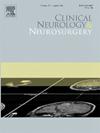The current state of academic neurosurgery: A national survey assessing academic neurosurgical capacity and perceived needs
IF 1.8
4区 医学
Q3 CLINICAL NEUROLOGY
引用次数: 0
Abstract
Background
While inequities in the provision of neurosurgical care exist worldwide, the specific challenges in academic neurosurgical capacity remain inadequately understood. We sought to evaluate current neurosurgical capacity in United States academic tertiary care centers with neurosurgical residency programs and assess perceived needs in their respective practice settings.
Methods
An online survey regarding human resources, medications, equipment, and infrastructure was distributed to all 117 residency programs in the US. Institutions were categorized using the Area Deprivation Index (ADI), a tool quantifying socioeconomic disadvantage, into low (0–50) or high (51–100) groups.
Results
Responses from 37 institutions were recorded (59 % low ADI, 41 % high ADI). Common limitations included shortages of floor beds (84 %), nurses (81 %), and Neurocritical Care Unit (NCCU) beds (77 %). The least available equipment were intraoperative MRI (49 % total, Low ADI: 59 %, High ADI: 33 %, p = 0.18) and exoscopes (51 % total, Low ADI: 59 %, High ADI:40 %, p = 0.32). The most desired change in human resources was more operating room (OR) nurses (86 %, Low ADI: 77 %, High ADI: 100 %, p = 0.07) and the most common desired infrastructural changes were for more ORs (81 % total, Low ADI: 73 %, High ADI: 93 %, p = 0.2), floor beds (70 % total, Low ADI:59 %, High ADI:87 %, p = 0.14) and NCCU beds (70 % total, Low ADI: 68 %, High ADI:73 %, p = 1.0).
Conclusions
Academic centers across the US may face challenges related to advanced equipment, infrastructure, and personnel. More deprived programs may experience greater limitations. Interventions to address these limitations may be necessary, but further research is needed to comprehensively and objectively assess neurosurgical capacity.
学术神经外科的现状:一项评估学术神经外科能力和感知需求的全国性调查
虽然在世界范围内提供神经外科护理存在不公平,但学术神经外科能力的具体挑战仍然没有得到充分的了解。我们试图通过神经外科住院医师项目评估美国学术三级护理中心当前的神经外科能力,并评估其各自实践环境中的感知需求。方法对美国所有117个住院医师项目进行了一项关于人力资源、药物、设备和基础设施的在线调查。使用区域剥夺指数(ADI),一种量化社会经济劣势的工具,将机构分为低(0-50)和高(51-100)组。结果37家机构的反馈(59 % ADI低,41 % ADI高)。常见的限制包括地板床位短缺(84% %)、护士短缺(81% %)和神经重症监护病房(NCCU)床位短缺(77% %)。最可用的设备是术中MRI(49 %,低ADI: 59 %,ADI高:33 % p = 0.18)和exoscopes(51 %,低ADI: 59 %,ADI高:40 % p = 0.32)。最期望的变化在人力资源是手术室护士(或)(86 %,ADI低:77 %,ADI高:100 % p = 0.07)和最常见的所需的基础设施变化口服补液盐(81 %,ADI低:73 %,ADI高:93 % p = 0.2),地板床(70 %,低ADI: 59 %,ADI高:87 % p = 0.14),其中床(70 %,ADI低:68 %,ADI高:73 % p = 1.0)。美国各地的学术中心可能面临与先进设备、基础设施和人员相关的挑战。更贫困的项目可能会遇到更大的限制。解决这些限制的干预措施可能是必要的,但需要进一步的研究来全面客观地评估神经外科能力。
本文章由计算机程序翻译,如有差异,请以英文原文为准。
求助全文
约1分钟内获得全文
求助全文
来源期刊

Clinical Neurology and Neurosurgery
医学-临床神经学
CiteScore
3.70
自引率
5.30%
发文量
358
审稿时长
46 days
期刊介绍:
Clinical Neurology and Neurosurgery is devoted to publishing papers and reports on the clinical aspects of neurology and neurosurgery. It is an international forum for papers of high scientific standard that are of interest to Neurologists and Neurosurgeons world-wide.
 求助内容:
求助内容: 应助结果提醒方式:
应助结果提醒方式:


